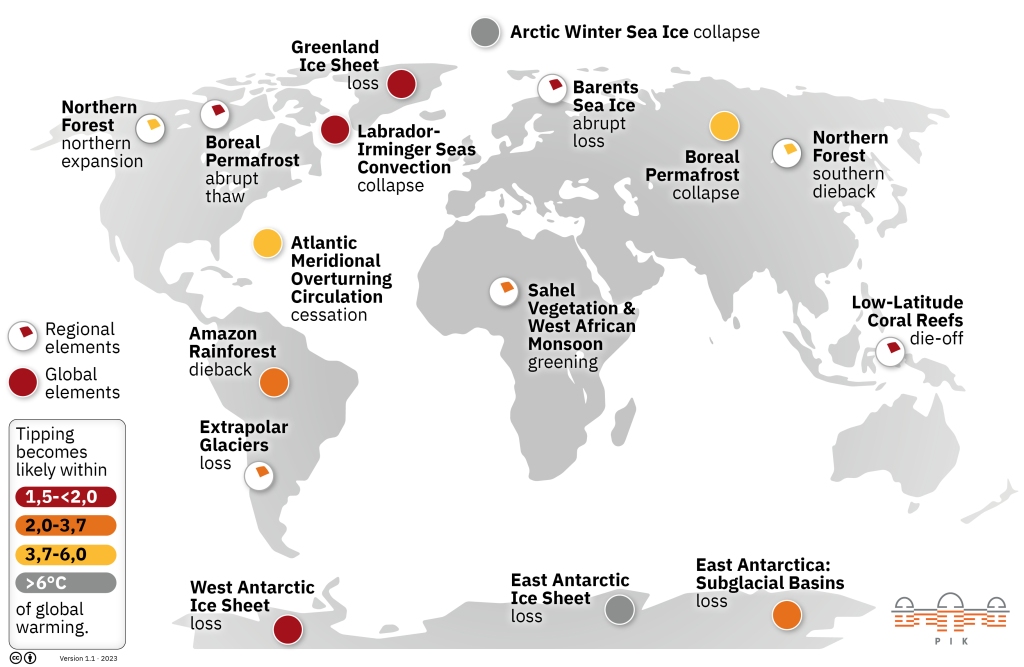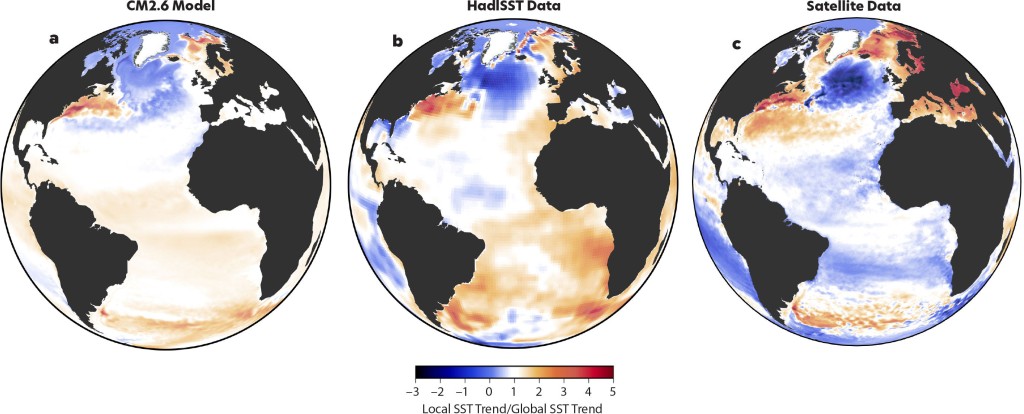The risk of tipping points in the climate system.
As the climate is changing, the Earth gets hotter and hotter. This leads to an increase in natural disasters, health problems, and displacement. However, this gradual change isn’t the only threat we face. There are also tipping points in our climate system. Once passed, there is no going back. Tipping points are various events, like the melting of the Greenland ice sheet, which, once started, cannot be stopped anymore. The triggers of the tipping points all correlate with a different rise in the average temperature on Earth. The higher the temperature, the more likely they get.

The geographical distribution of global and regional tipping elements, colour-coded according to the best estimate for their temperature thresholds, beyond which the element would likely be ‘tipped’. Figure designed at PIK (Potsdam Institute for Climate Impact Research, under cc-by licence), based on Armstrong McKay et al., Science (2022).
As seen in the graphic, there are a lot of different tipping points. They can be categorized as ice masses, ecosystems, and circulation. To understand the impact of tipping points better, we are taking a closer look at one of each category.
Greenland Ice Sheet
One of the tipping points in the climate system is the melting of the Greenland ice sheet. Greenland is covered with a three-kilometre-thick and permanent ice sheet. Due to the warming temperatures, this ice is melting already. Once a critical threshold is passed, there is no going back. Even if there would be no temperature rise anymore, the ice would melt fully and inevitably. It is also self-amplifying because the melting exposes more and more cold ice layers to the warmth, accelerating the process of melting. The critical threshold is around 1,5°C (possibly between 0.8°C and 3°C) of average global warming since the industrial revolution.
If the Greenland ice sheet melts, there will be a sea level rise of around seven meters. It could also affect other tipping points
Atlantic overturning circulation
The Atlantic overturning circulation is one branch of Earth’s global overturning circulation, which can be imagined as a great stream in the ocean. It transports warm water from the ocean’s surface to the north, where it cools and sinks, or overturns, to 2000 m – 3000 m depth. There it flows back south. This process takes up to 2000 years. The whole circulation is extremely important for the stability of the climate system. As seen in the past, a change in the circulation leads to drastic climatic changes.
The circulation works because of the differences in temperature and salinity between the water of the subtropics and the North Atlantic. The salty water is denser and heavier. As a result, it sinks in the north, where the surrounding water is less salty. It is a self-amplifying circle since it flows because it is salty, and it is salty because it flows.
Through global warming, this process slows down. The main reason is a decrease in the current’s salinity, either because of rain or meltwater. As a result, the water is less dense and sinks more slowly in the Northern Atlantic. This is called the “transportation feedback”. Beyond a critical threshold, the tipping point, it also becomes a self-amplifying system, leading to a vicious circle.
This tipping point is a good example of how the different tipping points influence each other. If the Greenland Ice Sheet is melting, it will also destabilize the overturning circulation. The exact tipping point is hard to define, there are too many factors which influence it. Still, there are different climate models, which predict different tipping points. Research suggests a threshold around 4°C (1.4-8°C) For example, in NASA’s climate model for a global warming of 3°C, the Atlantic overturning circulation collapses in two of ten simulations. In the others, it manages to recover after severe weakening. There is also the possibility of a circulation collapse in just one region.

(a) Result of the CM2.6 climate model (b) shows the observed trend over 1870–2016, and (c) plots data from the Copernicus satellite collected during 1993–2021. (a) and (b) from Caesar et al. (2018). (c) Courtesy of Ruijian Gou.
As predicted by climate models, one effect of a slower circulation would be a “cold blob” in the Atlantic Ocean. Everywhere, the ocean will get hotter. Only south of Greenland, it will get colder since the circulation doesn’t transport as much warm water as it used to. The theory of a “cold blob” is consistent with observations. This suggests that the Atlantic’s overturning circulation is already slowing down.
A collapse of the Atlantic current would lead to a massive increase in temperature, sea level rise and even the exchange of dry and wet seasons in the Amazon.
Coral Reefs
Coral reefs cover only a small part of the Earth’s surface, nevertheless, they support a quarter of all life in the ocean. They are one of the most biodiverse places on Earth and are essential for the marine food web. They are also critical for human economies, i.e. tourism and coastal protection.
Even without global warming, coral reefs are threatened by human activities like overfishing. But a certain temperature is overcrossed, they are abandoned by their symbiotic algae and bleach. After a while, they die.
Coral reefs have a critical temperature threshold of 1.5°C (1-2°C). If the tipping point is passed, there would be a total die-off. Around 40% of the coral reefs died, mostly during three heat waves in the past years. If global temperature warming stays below 1.5°C, there is a chance to save 10%-30% of coral reefs; over 2°C, it will be lost forever.
What can we do?
Since all of the thresholds correlate to the warming of the global temperature, we put all efforts into keeping the temperature rise as low as possible.
With the Paris Agreement in 2015, an international, legal-binding contract was made to keep the average temperature rise under 2°C, ideally under 1,5°C. This agreement was signed by 194 states and the EU. But even if this will be achieved, and it doesn’t look that way, there are at least seven tipping points which are still likely to happen. Maybe it already happened. Some thresholds are uncertain, but the risk of hitting them is too big to take.
“It would be irresponsible, even foolhardy, if policymakers, business leaders, and indeed the voting public continue to ignore those risks.” – Stefan Rahmstorf (Rahmstorf, S. 2024. Is the Atlantic overturning circulation approaching a tipping point?)
Johanna Krautkrämer
Sources:
Rahmstorf, S. 2024. Is the Atlantic overturning circulation approaching a tipping point? Oceanography, https://doi.org/10.5670/oceanog.2024.501.
pik-potsdam.de – Tipping Elements – big risks in the Earth System
youtube.com – Climate Tipping Points
edition.cnn.com – Critical Atlantic Ocean current system is showing early signs of collapse, prompting warning from scientists
en.wikipedia.org – Paris Agreement – Wikipediayoutube.com – The scariest climate science paper I’ve ever read


Leave a comment